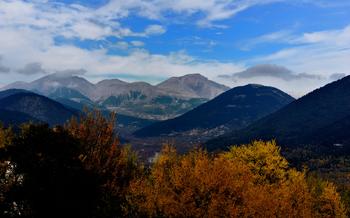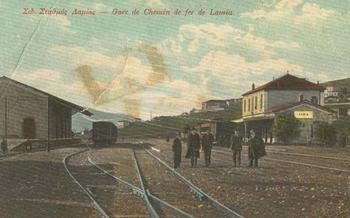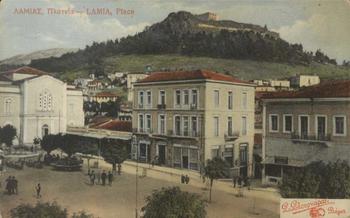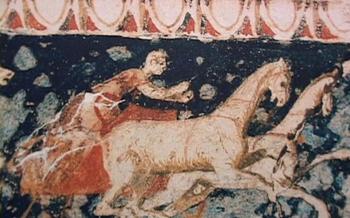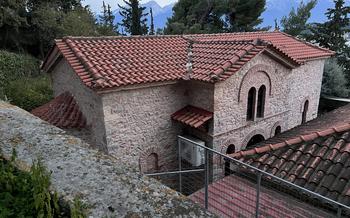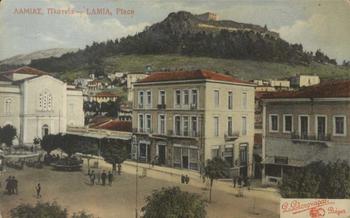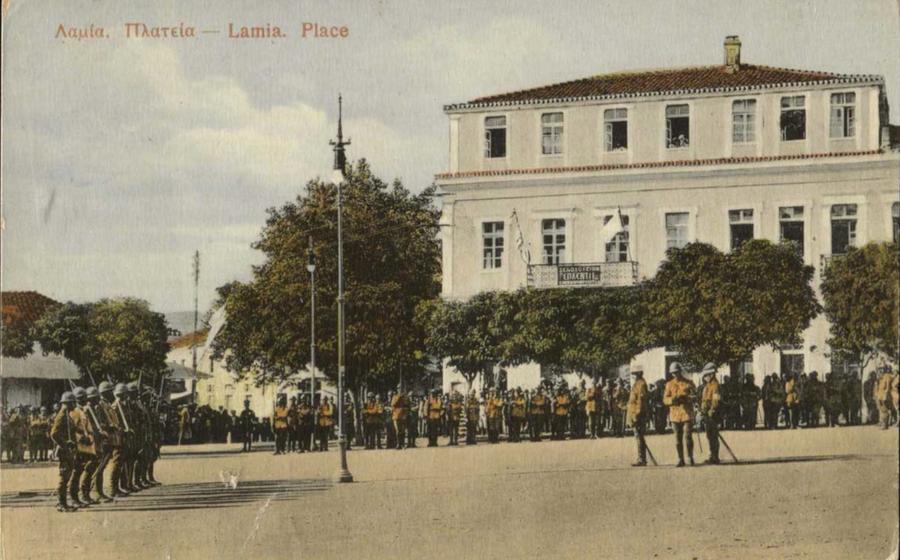
Anthili Roman Aqueduct
- Historical Significance
- Location
- Dimensions
- Architectural Features
- Construction Techniques
- Travel Tips
- Guided Tours
- History of the Aqueduct
- Integrating Nature
- Best Views
- Alternative Activities
- Historical Figures
- Social and Cultural Significance
- Insider Tip: Unveiling the Hidden Photographic Gem
Historical Significance
The Anthili Roman Aqueduct in Greece stands as a testament to the remarkable engineering prowess of the Roman Empire. Constructed during the Roman period, this impressive structure played a vital role in providing Lamia and its surrounding areas with a reliable water supply. The aqueduct's construction reflects the Romans' advanced understanding of hydraulics and their ability to harness natural resources for the benefit of their communities.
Preservation efforts have been instrumental in maintaining the integrity of the aqueduct. Restoration work has been carried out to ensure that this ancient marvel continues to captivate visitors and serve as a reminder of the enduring legacy of Roman engineering.
Location
The Anthili Roman Aqueduct is in the village of Anthili, about 10 kilometers (2 miles) southwest of the city of Lamia, in Central Greece. It is situated in a picturesque valley surrounded by rolling hills and lush vegetation. The aqueduct is easily accessible by car, with a well-maintained road leading directly to the site. Visitors can also reach the aqueduct by public transportation, as there are regular buses from Lamia to Anthili. The convenient location, within a short distance from the city center, makes it an ideal destination for a day trip from Lamia or as part of a broader exploration of the region.
Dimensions
The Anthili Roman Aqueduct is a remarkable feat of ancient engineering, spanning an impressive 400 meters in length. This architectural marvel stands tall, reaching heights of up to 13 meters, making it a majestic sight to behold. The aqueduct's sheer size and scale are a testament to the ingenuity and skill of the Roman builders who constructed it centuries ago.
Architectural Features
The Anthili Roman Aqueduct stands out for its unique design, combining functionality with aesthetic beauty. Constructed entirely of stone, the aqueduct features a series of arches and pillars that create a harmonious and visually striking structure. The arches, which vary in size and shape, were meticulously engineered to distribute the weight of the water evenly, ensuring the stability of the aqueduct. The pillars, on the other hand, provide support and add to the overall grandeur of the structure. Despite centuries of exposure to the elements, the aqueduct remains in an impressive state of preservation, a testament to the skill and ingenuity of the Roman builders.
Construction Techniques
The Anthili Roman Aqueduct stands as a testament to the remarkable engineering prowess of the ancient Romans. Constructed using time-tested methods and materials, it remains a marvel of structural ingenuity.
Roman engineers employed arches and pillars as the primary structural components of the aqueduct. The arches, with their inherent strength and ability to distribute weight efficiently, allowed the aqueduct to span vast distances and withstand the test of time. The pillars, positioned strategically along the structure, provided additional support and stability, ensuring its resilience against the forces of nature.
The aqueduct's construction involved meticulously cut stone blocks, carefully fitted together without the use of mortar. This technique, known as dry stone construction, showcased the Romans' mastery of precision engineering. The interlocking blocks created a sturdy and durable structure, capable of withstanding centuries of wear and tear.
Throughout the aqueduct's construction, meticulous attention was paid to water flow and pressure. The Romans ingeniously incorporated sloping channels and sedimentation basins to regulate water flow and prevent blockages. These features ensured a consistent and reliable water supply, essential for sustaining the growing population of ancient Lamia.
Travel Tips
Ideal Time to Visit
The best time to visit the Anthili Roman Aqueduct is during the spring or fall when the weather is pleasant and mild. Summer can be quite hot, especially during the midday hours. During the winter, the aqueduct may be covered in snow, making it difficult to navigate.
Duration of Visit
Allow yourself at least an hour to explore the aqueduct. If you are interested in taking a guided tour, you should plan on spending about two hours.
Facilities Available
There are several facilities available for visitors to the aqueduct. There is a small parking area, as well as a picnic area with tables and chairs. There are also restrooms available.
Guided Tours
Availability: Guided tours of the Anthili Roman Aqueduct are available throughout the year, except during inclement weather conditions.
Duration: Tours typically last for about an hour and provide a comprehensive overview of the aqueduct's history, construction techniques, and significance.
Cost: The cost of a guided tour varies depending on the size of the group and the time of year. However, it generally ranges from 10 to 20 euros per person.
Guided tours are an excellent way to learn more about the aqueduct and its importance. Knowledgeable guides will provide insights into the engineering prowess of the Romans and the role the aqueduct played in the development of Lamia and the surrounding region.
History of the Aqueduct
The Anthili Roman Aqueduct was constructed in the 2nd century AD, during the reign of Roman Emperor Hadrian. It was part of an ambitious infrastructure project aimed at providing a reliable water supply to the ancient city of Lamia. The aqueduct was in operation for several centuries, successfully supplying water to the city's inhabitants and contributing to its prosperity. Remains of the water distribution system, including canals and reservoirs, can still be seen in various parts of Lamia, attesting to the magnitude of this ancient engineering marvel.
Its construction marked a significant milestone in Roman engineering and infrastructure development. The aqueduct stands as a testament to the Romans' exceptional abilities in hydraulics and their commitment to providing essential services to their citizens, ensuring their well-being and improving their quality of life.
Integrating Nature
The Anthili Roman Aqueduct stands in harmonious coexistence with the natural world around it. The surrounding landscape, characterized by rolling green hills, offers a picturesque backdrop to this ancient structure. The area is home to a diverse array of wildlife, including birds, rabbits, and foxes, which can often be spotted in the vicinity of the aqueduct. Visitors can also explore the nature trails that meander through the surrounding countryside, providing an opportunity to immerse themselves in the tranquility of the natural surroundings.
Best Views
The Anthili Roman Aqueduct offers awe-inspiring panoramic vistas that will leave you breathless. Ascend to the upper levels of the structure to witness the sprawling countryside, a verdant tapestry of rolling hills, fertile valleys, and distant mountains. The landscape unfolds before you, revealing a picturesque panorama that seems to stretch to infinity.
At sunset, the aqueduct transforms into a magical realm, bathed in warm golden hues. As the sun dips below the horizon, the sky erupts in a vibrant tapestry of colors, casting a surreal glow upon the ancient structure. This ethereal spectacle is not to be missed, as the aqueduct stands silhouetted against the vibrant canvas of the setting sun, creating an unforgettable and awe-inspiring sight.
Alternative Activities
Beyond exploring the Anthili Roman Aqueduct, visitors can embark on a journey of discovery in Lamia and its surroundings.
-
Ancient Lamia: Delve into the rich history of Lamia by visiting the Archaeological Museum, showcasing artifacts from the city's ancient past, including ceramics, sculptures, and inscriptions.
-
Mount Oeta National Park: Escape into the picturesque landscapes of Mount Oeta National Park, known for its diverse flora and fauna. Embark on hiking trails, admire panoramic vistas, and encounter wildlife such as deer, eagles, and wolves.
-
Culinary Delights: Savor the flavors of traditional Greek cuisine in Lamia's tavernas and restaurants. Indulge in regional specialties like spit-roasted lamb, fresh seafood, and the famous "tyropita," a savory cheese pie.
Historical Figures
The story of the Anthili Roman Aqueduct is intertwined with the lives of several notable figures who played significant roles in its construction, preservation, and legacy. One of the most prominent figures is Gaius Cassius Longinus, a Roman governor of Greece during the 1st century AD. Longinus is widely believed to have commissioned the aqueduct's construction, recognizing the need for a reliable water supply for the growing city of Lamia. His vision and leadership were instrumental in bringing this impressive engineering feat to life.
Another key figure is Marcus Vitruvius Pollio, a renowned Roman architect and engineer who lived during the 1st century BC. Vitruvius is famous for his treatise "De Architectura," which discusses various aspects of Roman architecture, including aqueducts. It is believed that Vitruvius may have been involved in the design and construction of the Anthili Roman Aqueduct, using his expertise to ensure its structural integrity and efficiency.
Local folklore also mentions the legendary figure of Agios Nikolaos, who is said to have played a role in the aqueduct's preservation during the Byzantine period. According to legend, Agios Nikolaos intervened to protect the aqueduct from destruction by invading forces, saving it from ruin and ensuring its continued existence for centuries to come.
Social and Cultural Significance
The Anthili Roman Aqueduct holds immense social and cultural significance for the people of Lamia and the surrounding region. It serves as a tangible reminder of their rich history and the ingenuity of their ancestors. The aqueduct's endurance through the centuries has become a symbol of the community's resilience and determination.
Local residents take great pride in their association with this ancient marvel. It is a source of inspiration and a symbol of their collective heritage. The preservation and maintenance of the aqueduct are seen as a shared responsibility, ensuring that future generations can continue to appreciate its grandeur and significance.
Beyond its historical value, the aqueduct also plays a vital role in promoting cultural identity and tourism. It attracts visitors from around the world, who come to admire its architectural beauty and learn about its history. The presence of the aqueduct has helped boost the local economy, providing employment opportunities and supporting the development of tourism-related businesses.
Moreover, the aqueduct has become a popular gathering spot for locals and tourists alike. Its serene surroundings offer a respite from the hustle and bustle of city life, inviting people to come together, socialize, and appreciate the beauty of nature. The aqueduct's enduring presence has woven itself into the fabric of the local culture, serving as a source of pride, inspiration, and community spirit.
Insider Tip: Unveiling the Hidden Photographic Gem
As a seasoned travel photographer, I stumbled upon a hidden gem that offers a breathtaking perspective of the Anthili Roman Aqueduct. Just a short walk away from the main viewing area, tucked amidst the olive groves, lies an elevated spot that will elevate your photography game.
Set up your tripod and capture the aqueduct's majestic form against the backdrop of the sprawling Lamia countryside. As the golden hues of sunset bathe the landscape, the aqueduct transforms into a silhouette of grandeur, casting an enchanting spell upon the surroundings.
Remember to bring a wide-angle lens to capture the scale and majesty of the structure. Experiment with different shutter speeds to convey a sense of movement or stillness, depending on your artistic vision.
Whether you're an amateur or a professional photographer, this secret spot will provide you with the perfect composition to showcase the beauty and grandeur of the Anthili Roman Aqueduct. So, venture off the beaten path and let your creativity soar.
